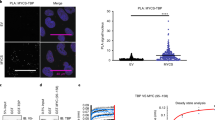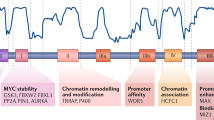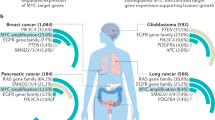Abstract
THE Myc family proteins are thought to be involved in transcription1,2 because they have both a carboxy-terminal basic–helix–loop–helix–zipper (bHLH-Z) domain, common to a large class of transcription factors3, and an amino-terminal fragment which, for c-Myc, has transactivating function when assayed in chimaeric constructs4. In addition, c-, N- and L-Myc proteins heterodimerize, in vitro and in vivo, with the bHLH-Z protein Max5–8. In vitro, Max homodimerizes but preferentially associates with Myc, which homodimerizes poorly5,6. Furthermore Myc-Max heterodimers specifically bind the nucleotide sequence CACGTG9 with higher affinity than either homodimer alone5. The identification of Max and the specific DNA-binding activities of Myc and Max provides an opportunity for directly testing the transcriptional activities of these proteins in mammalian cells. We report here that Myc overexpression activates, whereas Max overexpression represses, transcription of a reporter gene. Max-induced repression is relieved by overexpression of c-Myc. Repression requires the DNA-binding domain of Max, whereas relief of repression requires the dimerization and transcriptional activation activities of Myc. Both effects require Myc–Max-binding sites in the reporter gene.
This is a preview of subscription content, access via your institution
Access options
Subscribe to this journal
Receive 51 print issues and online access
$199.00 per year
only $3.90 per issue
Buy this article
- Purchase on Springer Link
- Instant access to full article PDF
Prices may be subject to local taxes which are calculated during checkout
Similar content being viewed by others
References
Kingston, R. E., Baldwin, A. S. & Sharp, P. A. Cell 41, 3–5 (1985).
Kaddurah-Daouk, R., Greene, J. M., Baldwin, A. S. & Kingston, R. E. Genes Dev. 1, 347–357 (1987).
Jones, N. Cell 61, 9–11 (1990).
Kato, G. J., Barrett, J., Villa-Garcia, M. & Dang, C. V. Molec. cell Biol. 10, 5914–5920 (1990).
Blackwood, E. M. & Eisenman, R. N. Science 251, 1211–1217 (1991).
Prendergast, G. C., Lawe, D. & Ziff, E. B. Cell 85, 395–407 (1991).
Blackwood, E. M., Lüscher, B. & Eisenman, R. N. Genes Dev. 6, 71–80 (1992).
Wenzel, A., Cziepluch, C., Hamann, U., Schümann, J. & Schwab, M. EMBO J. 10, 3703–3712 (1991).
Blackwell, T. K., Kretzner, L., Blackwood, E. M., Eisenman, R. N. & Weintraub, H. Science 250, 1149–1151 (1990).
Hann, S. R., Thompson, C. B. & Eisenman, R. N. Nature 314, 366–369 (1985).
Gregor, P. D., Sawadogo, M. & Roeder, R. G. Genes Dev. 4, 1730–1740 (1990).
Beckman, H., Su, L.-K. & Kadesch, T. Genes Dev. 4, 167–179 (1990).
Chiu, R. et al. Cell 54, 541–552 (1988).
Boyle, W. J. et al. Cell 64, 573–584 (1991).
Kato, G. J., Lee, W. M. F., Chen, L. & Dang, C. V. Genes Dev. 6, 81–92 (1992).
Hann, S. R. & Eisenman, R. N. Molec. cell. Biol. 4, 2486–2497 (1984).
Waters, C.M., Littlewood, T. D., Hancock, D. C., Moore, J. P. & Evan, G. I. Oncogene 6, 797–805 (1991).
Kelly, K., Cochran, B. H., Stiles, C. D. & Leder, P. Cell 35, 603–610 (1983).
Dean, M. et al. J. biol. Chem. 261, 9161–9166 (1986).
Ptashne, M. Nature 335, 683–689 (1988).
Rustgi, A. K., Dyson, N. & Bernards, R. Nature 352, 541–544 (1991).
Harland, R. & Weintraub, H. J. cell. Biol. 101, 1094–1099 (1985).
Gorman, C. M., Moffat, L. F. & Howard, B. H. Molec. cell. Biol. 2, 1044–1051 (1982).
Halazonetis, T. D. & Kandil, A. N. Proc. natn. Acad. Sci. U.S.A. 88, 6162–6166 (1991).
Nyborg, J. K. et al. J. biol. Chem. 265, 8237–8242 (1990).
Geballe, A. P. & Mocarski, E. S. J. Virol. 62, 3334–3340 (1988).
Berberich, S. J. & Cole, M. D. Genes Dev. 6, 166–176 (1992).
Author information
Authors and Affiliations
Rights and permissions
About this article
Cite this article
Kretzner, L., Blackwood, E. & Eisenman, R. Myc and Max proteins possess distinct transcriptional activities. Nature 359, 426–429 (1992). https://doi.org/10.1038/359426a0
Received:
Accepted:
Issue Date:
DOI: https://doi.org/10.1038/359426a0
This article is cited by
-
Obscure Involvement of MYC in Neurodegenerative Diseases and Neuronal Repair
Molecular Neurobiology (2021)
-
Gas6/Axl is the sensor of arginine-auxotrophic response in targeted chemotherapy with arginine-depleting agents
Oncogene (2016)
-
Analysis of ZNF350/ZBRK1 promoter variants and breast cancer susceptibility in non-BRCA1/2 French Canadian breast cancer families
Journal of Human Genetics (2013)
-
Myc proteins as therapeutic targets
Oncogene (2010)
-
Max-independent functions of Myc in Drosophila melanogaster
Nature Genetics (2008)
Comments
By submitting a comment you agree to abide by our Terms and Community Guidelines. If you find something abusive or that does not comply with our terms or guidelines please flag it as inappropriate.



